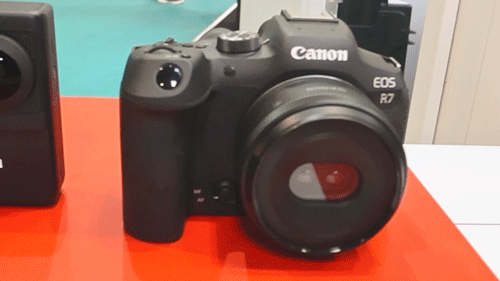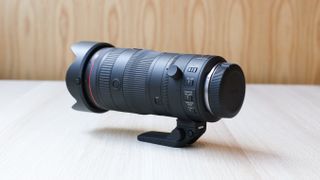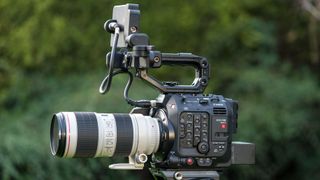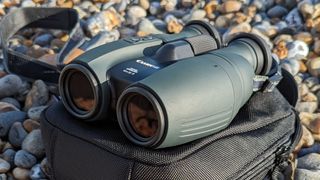
Quick List
1. Best overall
2. Best for high magnification
3. Best budget
4. Best for everyday use
5. Best for bird watchers
6. Best for travel
How to choose
How we test
Looking for the best image-stabilized binoculars? This guide will help you track down the best pair for your needs, and help you locate them at the best available price.
The larger and more powerful the binoculars, the trickier it is to hold them steady enough to achieve an image that is sharp and judder-free, as well as bright and clear. Image-stabilized binoculars attempt to solve this issue by compensating for the involuntary movement of your hands.
This clever anti-shake tech uses built-in integral gyro sensors responding to and correcting for wobble. For serious wildlife watchers and nature lovers, the difference it makes is worth paying the slight premium such IS models command.
Additionally, having body integral IS avoids the need to purchase an additional tripod and carry that around too – with most binos not actually offering a screw thread for tripod attachment anyway. A further benefit is that image stabilization reduces eyestrain when observing faraway subjects for long periods.
As with any binocular, though, we’ll also want to be paying attention to core features including magnification and objective lens size. The bigger the objective lens, the brighter the image runs the advice, while the greater the magnification, the closer we’ll be able to observe our faraway subject.
While it may broadly be the case that the higher both of these values, the bigger and bulkier the binos themselves, we’re always looking for the device that gets that ‘sweet spot’ just right for the subjects you are using the binoculars for. Higher magnifications can amplify any slight tremor or wobble when hand-holding, though, so with these image stabilization is even more welcome
So, without further ado, let’s survey some candidates for the best image-stabilized binoculars we can buy right now…

For nearly two decades Sebastian's work has been published internationally. Originally specializing in Equestrianism, his photos have been used The Fédération Equestre Internationale (FEI), The Jockey Club, Horse & Hound, and many more.
As well as being a pro sports photographer he is also a big country sportsman who can be often found in or around the shooting field, sailing on the open sea, or taking part in other country pursuits, and quite often has either a pair of binoculars, a monocular or a scope in his hand.
Quick List
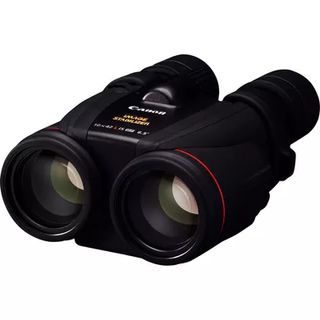
Canon is the leader in image-stabilized binoculars, and these are its premium pair with ‘L’ grade optical quality – denoted by a tell-tale red ring – matched to a large 42mm sized objective lens, making these great for low light.
Read more below
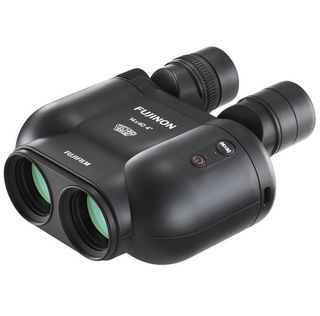
An upgraded pair of Fujinon branded binos from Fujifilm for the purists, with both a powerful 14x magnification which is great for surveillance of a stationary subject - such as monitoring a nesting site.
Read more below
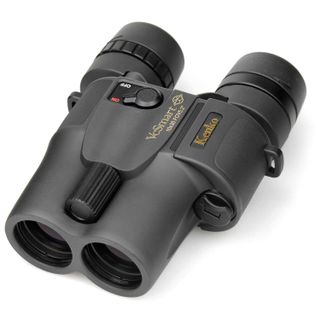
A compact and slender new binocular without the pedigree of a Canon, perhaps, but one that makes a claim for being the smallest pair of binos with image stabilization out there – with plenty more useful features besides.
Read more below
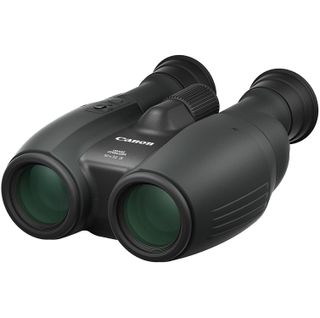
If you really want image-stabilized binoculars but want to try and save on the bulk, then these are a great compromise between magnification and image brightness - making them a great choice for all-round everyday use.
Read more below
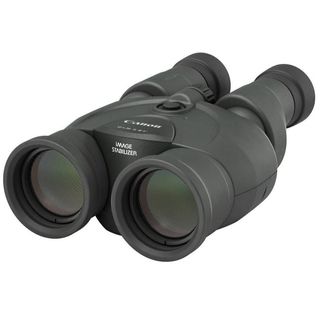
If you're a true twitcher and just love observing birds of all species these are the best for bird watchers on our list that offer IS and a high magnification.
Read more below
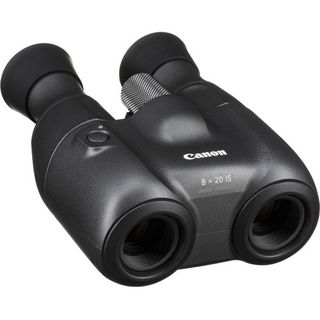
These are Canon's smallest and most affordable IS binoculars - making them a great choice for hiking, or for holidays. They don't give the brightest image, so best used in daylight.
Read more below
Best image stabilized binoculars in 2024
Why you can trust Digital Camera World
Best overall
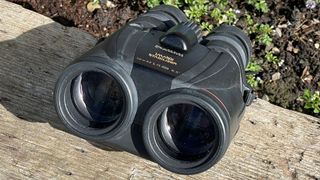

As someone who's interested in binoculars, I've been intrigued by Canon's offering, especially their top-tier 'L' grade optical quality showcased by the distinctive red ring in the binocular range. Paired with the sizable 42mm objective lens, it promises impressive visual clarity.
Given the significant investment, it's comforting to know that the binoculars are well-built, with O-ring sealing ensuring waterproofing. The image stabilization (IS) feature, powered by Canon's Vari-Angle Prism system, utilizes gyro sensors and microprocessors for steady viewing.
Some noteworthy features include a generous 16mm long eye relief, anti-fog technology, and a rubberized exterior for added durability. The wide 65° angle of view and large 4.2mm exit pupil also contribute to a bright view, even in low-light conditions.
Sure, spending over a grand on binoculars isn't a light decision, but the Canon 10x42 L IS WP binoculars offer serious performance that justifies the investment, whether you're on this side of the Atlantic or the other.
Read our full Canon 10x42 L IS WP Binocular review for more details
Best for high magnification
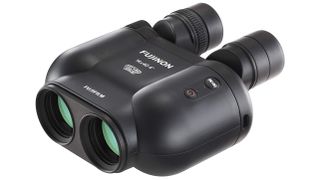
I recently came across the upgraded Fujinon binoculars from Fujifilm, and as a purist, they caught my attention right away. Offering a powerful 14x magnification and a sizable 40mm objective lens, they promise exceptional viewing quality.
In my research, I found that this newer version boasts a wider stabilization range of +/- 6° for steady viewing, a significant improvement over the previous model. What's more, it now runs on rechargeable NiMH batteries, providing up to 12 hours of uninterrupted use – perfect for long observation sessions.
The binoculars utilize optoelectronic image stabilization combined with vibration suppression technology, ensuring clear and shake-free viewing. I particularly appreciate the automatic power-down feature, which helps conserve battery life when not in use.
With a curved exterior design for a comfortable grip, twist-up eyecups, and fog-proof construction, these binoculars are versatile enough for observing nature or sporting events alike. While they are the heaviest option I've come across at 1.32kg, the added weight is offset by the provided carry case and strap.
Although the price tag is substantial, I find the additional features justify the investment. Plus, the waterproofing is so robust that these binoculars will actually float if accidentally dropped overboard, adding to their appeal.
Best budget
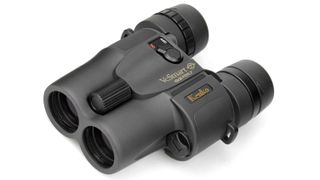
A compact and slender new binocular without the pedigree of a Canon, perhaps, but one that makes a claim for being the smallest pair of binos with image stabilization out there – with plenty more attendant features besides.
These of course include built-in image stabilization along with the equally expected feature of fully multi-coated lenses to enhance light transmission and provide color fidelity. With a 5.2° field of view, the item weighs a tad more than its Canon competitors at just over half a kilogram, yet provides twist-up eyecups for the comfort of users.
As well as image stabilization/vibration control, which can be activated or deactivated at the flick of a lever and negates the need for a tripod, the core features to focus on are the 10x magnification matched to a 30mm objective lens, which means that it falls somewhere in the middle of the competing offerings here. A case and strap are included out of the box. Now that’s Smart.
Best for everyday use
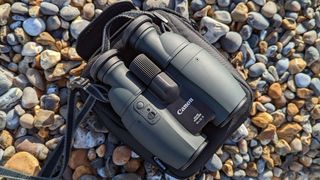
These stabilized binoculars give a massive advantage to observers by steadying views and reproducing them faithfully to real life, only magnified. We didn’t put these down the entire time we had them in for review but there are some drawbacks that only deserve to be mentioned because of their price. Namely, chromatic aberration and lens fogging.
We don’t think these issues should be happening at this price but they do not detract from the fun of using them. If you haven’t tried IS binoculars before, you’ll never want to return them after trying them. If you can afford it and the fogging doesn’t bother you, go for this pair.
Read our full Canon 10x32 IS binoculars review for more details
Best for bird watchers
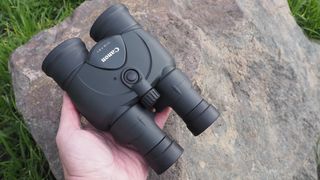
Marrying a generous 12x magnification to a respectable 36mm sized objective lens, Canon’s middle-of-range image stabilized Porro prism binocular purports to offer a clear, flat view from edge to edge, while being ideally suited to bird watchers and sports fans.
The onboard anti-shake system, which employs a combination of gyro sensors and a microprocessor, is claimed to be so reliable that a steady view is provided even from a moving vehicle, while the batteries required for it to work last up to nine hours of use.
Once again, the binos utilize the same Super Spectra lens coating as utilized in Canon’s EF camera lens range, with the aim of providing high-resolution viewing with low distortion, while preventing ghosting and scattered light.
A robust rubber coating to the exterior of the device further aids a steady grip, while the image stabilizer button and focus knob are centrally positioned for quick and easy access and equally swift response. A very well-specified model overall.
See our full Canon 12x36 IS III review
Best image-stabilizing binoculars for travel
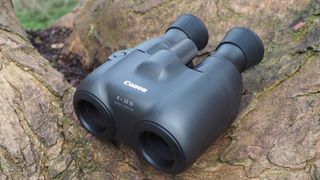
Proving that not all image-stabilized binoculars are big and heavy is this travel-friendly Porro prism example from Canon that shoehorns an 8x magnification, 20mm objective lens, and lens shift shake reduction system into a compact device weighing a very manageable 420g.
While this makes it suited to everyday use, it’s not only the built-in image stabilization – as also used in Canon RF and EF lenses for its cameras – that provides us with a sharp and clear view, but also a Super Spectra Coating to the glass.
A tactile focusing wheel is provided between the adjustable eyecups, so our eyes never need to leave our subject, while a dioptric adjustment is provided too; useful for those wearing spectacles.
The CR123A battery that powers the IS feature here is good for up to 12 hours of use but needs to be bought separately. And then there’s the overall price. Yes, we may pay a premium over non ‘IS’ binos with the same core level of specification, but this is the entry-level option in its manufacturer’s lineup and a good starter option nonetheless.
Read our full Canon 8x20 IS review
How to choose
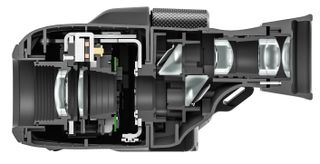
What do the numbers, such as 10x42, stand for on binoculars?
Binoculars always have two numbers in their name - such as 10x42 or 8x20. These two numbers refer to the binoculars' are magnification and lens size.
So with a 10x42 pair you have binoculars with 10x magnification and a lens diameter of 42mm.
It is tempting to choose binoculars with the highest magnification - but this will mean they will be larger, and limit your field of view - making them harder to pinpoint some subjects. The higher the magnification, though, the harder it is to keep them steady - making the benefit of image stabilization even greater.
The second number is the objective lens size - with a larger lens making the image brighter which is particularly beneficial in low light conditions.
In practice it is the combination of the two numbers that actually tell you how bright the image will be. If you divide the lens size by the magnification you get what is known as the "exit pupil size". For a pair of 8x20 binoculars, the exit pupil is 2.5 – and for a pair of 10x42 binos it is 4.2. If you need to regularly use your image-stabilized binoculars in poor light conditions (say at dusk), then choose one where this ratio is 4 or greater.
How we test IS binoculars
In our buying guides, we look for image stabilization binoculars that are of good construction and that can withstand the abuse of the day-to-day activity of birdwatching and wildlife spotting while maintaining a steady, judder-free image thanks to the built-in IS.
Magnification is also a big factor and we like to offer a wide range to suit everyone's preference. Budget is also an indicator, and within this buying guide, you will find items to suit everyone's budget and needs.

